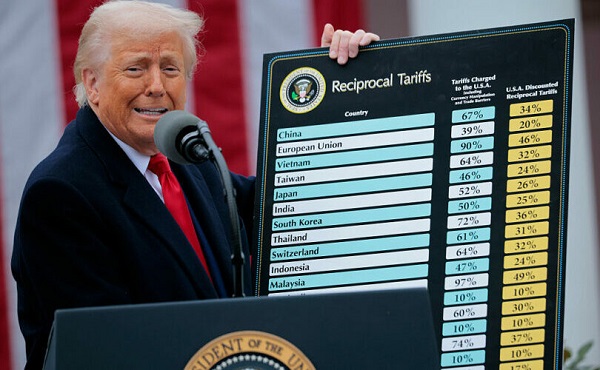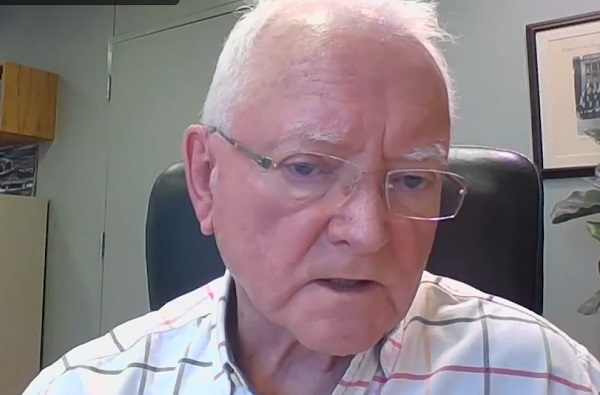Business
CIA Offers To Payout Entire Agency: REPORT


From the Daily Caller News Foundation
By Hailey Gomez
The Central Intelligence Agency (CIA) reportedly offered payouts to its entire workforce Tuesday, according to The Wall Street Journal.
The CIA has apparently become the first intelligence agency to offer its employees a way out, as they were reportedly offered a bid to quit their jobs in exchange for roughly eight months of pay and benefits, the outlet reported. Trump administration officials told the outlet that the move is a signal to help those who oppose President Donald Trump’s agenda find other work.
In addition to the offer, the WSJ reported that an aide to CIA Director John Ratcliffe said the agency is freezing its hiring for job seekers with conditional offers, with some expected to be rescinded if the agents don’t have the background necessary for the agency’s new direction.
Dear Readers:
As a nonprofit, we are dependent on the generosity of our readers. Please consider making a small donation of any amount here. Thank you!
“Director Ratcliffe is moving swiftly to ensure the CIA workforce is responsive to the Administration’s national security priorities. These moves are part of a holistic strategy to infuse the Agency with renewed energy, provide opportunities for rising leaders to emerge, and better position the CIA to deliver on its mission,” a CIA spokesperson told the Daily Caller News Foundation.
Ratcliffe was confirmed as the CIA’s new leader on Jan. 23, after the Senate approved him in a 74-25 vote. In his opening remarks during his confirmation process, Ratcliffe said he would adhere to the CIA’s core mission and focus on threats from the Chinese Communist Party.
“We will collect intelligence — especially human intelligence — in every corner of the globe, no matter how dark or difficult,” Ratcliffe said in his testimony. “We will produce insightful, objective, all-source analysis, never allowing political or personal biases to cloud our judgement or infect our products. We will conduct covert action at the direction of the president, going places no one else can go and doing things no one else can do.”
The move from the CIA comes a week after the U.S. Office of Personnel Management released an email on Jan. 28, showing that millions of federal employees were offered deferred compensation through Sept. 30, provided they submit their resignation notices by Feb. 6.
“If you choose to remain in your current position, we thank you for your renewed focus on serving the American people to the best of your abilities and look forward to working together as part of an improved federal workforce,” the email said. “At this time, we cannot give you full assurance regarding the certainty of your position or agency but should your position be eliminated you will be treated with dignity and will be afforded the protections in place for such positions.”
Business
Closing information gaps to strengthen Canada’s border security and track fentanyl

By Sean Parker, Dawn Jutla, and Peter Copeland for Inside Policy
To promote better results, we lay out a collaborative approach
Despite exaggerated claims about how much fentanyl is trafficked across the border from Canada to the United States, the reality is that our detection, search, and seizure capacity is extremely limited.
We’re dealing with a “known unknown”: a risk we’re aware of, but don’t yet have the capacity to understand its extent.
What’s more, it may be that the flow of precursor chemicals—ingredients used in the production of fentanyl—is where much of the concern lies. Until we enhance our tracking, search, and seizure capacity, much will remain speculative.
As border security is further scrutinized, and the extent of fentanyl production and trafficking gets brought into sharper focus, the role of the federal government’s Precursor Chemical Risk Management Unit (PCRMU)—announced recently by Health Canada—will become apparent.
Ottawa recently took action to enhance the capabilities of the PCRMU. It says the new unit will “provide better insights into precursor chemicals, distribution channels, and enhanced monitoring and surveillance to enable timely law enforcement action.” The big question is, how will the PCRMU track the precursor drugs entering into Canada that are used to produce fentanyl?
Key players in the import-export ecosystem do not have the right regulatory framework and responsibilities to track and share information, detect suspect activities, and be incentivized to act on it. That’s one of the reasons why we know so little about how much fentanyl is produced and trafficked.
Without proper collaboration with industry, law enforcement, and financial institutions, these tracking efforts are doomed to fail. To promote better results, we lay out a collaborative approach that distributes responsibilities and retools incentives. These measures would enhance information collection capabilities, incentivize system actors to compliance, and better equip law enforcement and border security services for the safety of Canadians.
Trade-off bottleneck: addressing the costs of enhanced screening
To date, it’s been challenging to increase our ability to detect, search, and seize illegal goods trafficked through ports and border crossings. This is due to trade-offs between heightened manual search and seizure efforts at ports of entry, and the economic impacts of these efforts.
In 2024, the Canada Border Services Agency (CBSA) admitted over 93 million travelers. Meanwhile, 5.3 million trucks transported commercial goods into Canada, around 3.6 million shipments arrived via air cargo, nearly 2 million containers were processed at Canadian ports, roughly 1.9 million rail cars carried goods into the country, and about 145.7 million courier shipments crossed the border. The CBSA employs a risk-based approach to border security, utilizing intelligence, behavioral analysis, and random selection to identify individuals or shipments that may warrant additional scrutiny. This triaging process aims to balance effective enforcement with the facilitation of legitimate travel and trade.
Exact percentages of travelers subjected to secondary inspections are not publicly disclosed, but it’s understood that only a small fraction undergo such scrutiny. We don’t learn about the prevalence of these issues through our border screening measures, but in crime reporting data—after it’s too late to avert.
It’s key to have an approach that minimizes time and personnel resources deployed at points of entry. To be effective without being economically disruptive, policymakers, law enforcement, and border security need to strengthen requirements for information gathering, live tracking, and sharing. Legislative and regulatory change to require additional information of buyers and sellers—along with stringent penalties to enforce non-compliance—is a low-cost, logistically efficient way of distributing responsibility for this complex and multifaceted issue. A key concept explored in this paper is strengthening governance controls (“controls”) over fentanyl supply chains through new processes and data digitization, which could aid the PCRMU in their strategic objectives.
Enhanced supply chain controls are needed
When it comes to detailed supply chain knowledge of fentanyl precursor chemicals moving in and out of Canada, regulator knowledge is limited.
That’s why regulatory reform is the backbone of change. It’s necessary to ensure that strategic objectives are met by all accountable stakeholders to protect the supply chain and identify issues. To rectify the issues, solutions can be taken by the PCRMU to obtain and govern a modern fentanyl traceability system/platform (“platform”) that would provide live transparency to regulators.
A fresh set of supply chain controls, integrated into a platform as shown in Fig. 1, could significantly aid the PCRMU in identifying suspicious activities and prioritizing investigations.

Our described system has two distinctive streams: one which leverages a combination of physical controls such as package tampering and altered documentation against a second stream that looks at payment counterparties. Customs agencies, transporters, receivers, and financial institutions would have a hand in ensuring that controls in the platform are working. The platform includes several embedded controls to enhance supply chain oversight. It uses commercially available Vision AI to assess packaging and blockchain cryptography to verify shipment documentation integrity. Shipment weight and quantity are tracked from source to destination to detect diversion, while a four-eyes verification process ensures independent reconciliation by the seller, customs, and receiver. Additionally, payment details are linked to shipments to uncover suspicious financial activity and support investigations by financial institutions and regulators like FINTRAC and FINCEN.
A modern platform securely distributes responsibility in a way that’s cost effective and efficient so as not to overburden any one actor. It also ensures that companies of all sizes can participate, and protects them from exploitation by criminals and reputational damage.
In addition to these technological enhancements and more robust system controls, better collaboration between the key players in the fentanyl supply chain is needed, along with policy changes to incentivize each key fentanyl supply chain stakeholder to adopt the new controls.
Canadian financial institutions: a chance for further scrutiny
Financial institutions (FIs) are usually the first point of contact when a payment is being made by a purchaser to a supplier for precursor chemicals that could be used in the production of fentanyl. It is crucial that they enhance their screening and security processes.
Chemicals may be purchased by wires or via import letters of credit. The latter is the more likely of the two instruments to be used because this ensures that the terms and conditions in the letter of credit are met with proof of shipment prior to payment being released. Payments via wire require less transparency.
Where a buyer pays for precursor chemicals with a wire, it should result in further scrutiny by the financial institution. Requests for supporting documentation including terms and conditions, along with proof of shipment and receipt, should be provided. Under new regulatory policy, buyers would be required to place such supporting documentation on the shared platform.
The less transparent a payment channel is in relation to the supply chain, the more concerning it should be from a risk point of view. Certain payment channels may be leveraged to further mask illicit activity throughout the supply chain. At the onset of the relationship the seller and buyers would link payment information on the platform (payment channel, recipient name, recipient’s bank, date, and payment amount) to each precursor or fentanyl shipment. The supplier, in turn, should record match payment information (payment channel, supplier name, supplier’s bank, date, and payment amount).
Linking payment to physical shipment would enable data analytics to detect irregularities. An irregularity is flagged when the amounts and/or volume of payments far exceed the value of the received goods or vice versa. The system would be able to understand which fentanyl supply chains tend to use a particular set of FIs. This makes it possible to conduct real-time mapping of companies, their fentanyl and precursor shipments and receipts, and the payment institutions they use. With this bigger picture, FIs and law enforcement could connect the dots faster.
Live traceability reporting
Today, suppliers of fentanyl precursors are subject to the Pre-Export Notification Online (PEN Online) database. This database enables governments to monitor international trade in precursor chemicals by sending and receiving pre-export notifications. The system helps prevent the diversion of chemicals used in the illicit manufacture of drugs by allowing authorities to verify the legitimacy of shipments before they occur.
To further strengthen oversight, the platform utilizes immutability technologies—such as blockchain or secure immutable databases—which can be employed to encrypt all shipping documents and securely share them. This presents an auditable form of chain-of-custody and makes any alterations apparent. Customs and buyers would have the capability to verify the authenticity of the originating documents in a way that doesn’t compromise business confidentiality. With the use of these technologies, law enforcement can narrow down their investigations.
An information gap currently exists as the receivers of the shipments don’t share their receipts information with PEN. To strengthen governance on fentanyl supply chains, regulatory policy and legislative changes are needed. The private sector should be mandated to report received quantities of fentanyl or its precursors, as well as suspicious receiving destinations. This could be accomplished on the platform which would embed the receiving process, a reconciliation process of the transaction, the secure upload and sharing of documents, and would be minimally disruptive to business processes.
Additionally, geo-location technology embedded in mobile devices and/or shipments would provide real-time location-based tracking of custody transactions. These geo-controls would ensure accountability across the fentanyl supply chain, in particular where shipments veer off or stop too long on regular shipping routes. Canadian transporters of fentanyl and its precursor chemicals should play an important role in detecting illicit diversion/activities.
Digital labelling
Licensed fentanyl manufacturers could add new unique digital labels to their shipments to get expedited clearance. For example, immutable digital labelling platforms enable tamper-proof digital labels for legitimate fentanyl shipments. This would give pharmacies, doctors, and regulators transparency into the fentanyl’s:
- Chemical composition and concentrations (determining legitimate vs. adulterated versions of the drug)
- Manufacturing facility ID, batch ID, and regulatory compliance status
- Intended buyer authentication (such as licensed pharmaceutical firms or distributors)
Immutable digital labelling platforms offer secure role-based access control. They can display customized data views according to time of day, language, and location. Digital labels could enable international border agencies and law enforcement to receive usable data, allowing legal shipments through faster while triggering closer shipment examinations for those without of a digital label.
International and domestic transporter controls
Transporters act as intermediaries in the supply chain. Their operations could be monitored through a regulatory policy that mandates their participation in the platform for fentanyl and precursor shipments. The platform would support a mobile app interface for participants on-the-move, as well as a web portal and application programming interfaces (APIs) for large-size supply chain participants. Secure scanning of packaging at multiple checkpoints, combined with real-time tracking, would provide an additional layer of protection against fraud, truckers taking bribes, and unauthorized alterations to shipments and documents.
Regulators and law enforcement participation
Technology-based fentanyl controls for suppliers, buyers, and transporters may be reinforced by international customs and law enforcement collaboration on the platform. Both CBSA and law enforcement could log in and view alerts about suspicious activities issued from the FIs, transporters, or receivers. The reporting would allow government personnel to view a breakdown of fentanyl importers, the number of import permit applications, and the amount of fentanyl and its precursors flowing into the country. Responsible regulatory agencies—such as the CBSA and PCRMU—could leverage the reporting to identify hot spots.
The platform would use machine learning to support CBSA personnel in processing an incoming fentanyl or precursor shipment. Machine learning refers to AI algorithms and systems that improve their knowledge with experience. For example, an AI assistant on the traceability system could use machine learning to predict and communicate which import shipments arriving at the border should be passed. It can base these suggestions on criteria like volume, price, origin of raw materials, and origin of material at import point. It can also leverage data from other sources such as buyers, sellers, and banks to make predictions. As an outcome, the shipment may be recommended to pass, flagged as suspicious, or deemed to require an investigation by CBSA.
It’s necessary to keep up to date on new precursor chemicals as the drug is reformulated. Here, Health Canada can play a role, using its new labs and tests—expected as part of the recently announced Canadian Drug Analysis Centre—to provide chemical analysis of seized fentanyl. This would inform which additional chemical supply chains should be tracked in the PCRMU’s collaborative platform, and all stakeholders would widen their scope of review.
These new tools would complement existing cross-border initiatives, including joint U.S.-Canada and U.S.-Mexico crackdowns on illicit drug labs, as well as sovereign efforts. They have the potential to play a vital role in addressing fentanyl trafficking.
A robust, multi-pronged strategy—integrating existing safeguards with a new PCRMU traceability platform—could significantly disrupt the illegal production and distribution of fentanyl. By tracking critical supply chain events and authenticating shipment data, the platform would equip law enforcement and border agencies in Canada, the U.S., and Mexico with timely, actionable intelligence. The human toll demands urgency: from 2017 to 2022, the U.S. averaged 80,000 opioid-related deaths annually, while Canada saw roughly 5,500 per year from 2016 to 2024. In just the first nine months of 2024, Canadian emergency services responded to 28,813 opioid-related overdoses.
Combating this crisis requires more than enforcement. It demands enforceable transparency. Strengthened governance—powered by advanced traceability technology and coordinated public-private collaboration—is essential. This paper outlines key digital controls that can be implemented by global suppliers, Canadian buyers, transporters, customs, and financial institutions. With federal leadership, Canada can spearhead the adoption of proven, homegrown technologies to secure fentanyl supply chains and save lives.
Sean Parker is a compliance leader with well over a decade of experience in financial crime compliance, and a contributor to the Macdonald-Laurier Institute.
Dawn Jutla is the CEO of Peer Ledger, the maker of a traceability platform that embeds new control processes on supply chains, and a professor at the Sobey School of Business.
Peter Copeland is deputy director of domestic policy at the Macdonald-Laurier Institute.
Business
Trump’s tariff plan replaces free trade with balanced trade. Globalists hate that.

From LifeSiteNews
By Frank Wright
While globalists screech that Trump has descended into ‘madness,’ his ‘Liberation Day’ tariff plan that has shocked global markets is actually rooted in the combination of two economic theories that argue for ‘balanced’ trade over ‘free’ trade.
We are used to seeing the effects of Trump Derangement Syndrome in the blue-haired, red-faced hysterics who call the President “Orange Hitler.” Yet the introduction of tariffs on “Liberation Day” has seen the constituency of the differently-saned explode in a fit of rage at this “tariff madness.”
As global markets “plunge,” Trump replied to critics that “sometimes you have to take medicine to fix something.”
“We have been treated so badly by other countries – because we had stupid leadership that allowed this to happen. They took our businesses, they took our money, they took our jobs,” he says, saying American wealth has been effectively “moved” abroad. Trump promised that this “will eventually be straightened out – and our country will be solid and strong again”.
Taking Trump’s medicine
Is his remedy worse than the disease? MSNBC said the crash in global stock markets was the “cascading effect of stupid” tariffs imposed by Trump on U.S. imports. Britain’s Sky News came out swinging too, saying they were “the biggest assault on global trade since World War Two.”
Stocks in the USA, London, Europe, China and across Asia have “plummeted,” as the BBC and others have reported. The U.K.’s Financial Times said “political pressure” resulting from the painful “medicine” will mean “Trump’s tariffs won’t last long.” Yet the liberal bastion of The Guardian dared to suggest there may be a “masterplan” in “shaking up the global economy.”
Looking beyond the hysterical headlines, one writer on SubStack – Tree of Woe – has read the book on “scaled tariffs” which explains the method in Trump’s so-called madness.
1. Trump delivers
Tree of Woe, who recommends the medicine of “muscular Christianity” to combat the sickness of our times, introduces his readers to the fact that Trump campaigned on: “…plac[ing] tariffs that would raise revenue, protect American manufacturing, and restore balanced trade to our global economy.”
This was followed up on April 2 with the imposition of scaled tariffs – called “Liberation Day for American Trade” by Trump:
As Tree of Woe notes, the reaction from the globalist media was exceptional – even for them:
Soon after the unveiling of Trump’s executive order, the forces of neoliberal globalism orchestrated a counterattack of such rhetorical fierceness and economic malignity that it is virtually unparalleled in the history of fiercely malign economic rhetoric.
Anything seen as a threat to the liberal globalist forced consensus is branded as stupid, extremist or destructive. And so it was with the tariffs, whose aim is to replace imbalance and deepening debt with fair trade – and sustainable prosperity.
2. Theoretical basis for tariffs
Woe then shows how a book on economics provides the “theoretical basis for the Liberation Day tariffs.”
The book is called “Balanced Trade: Ending the Unbearable Cost of America’s Trade Deficits.” It was published in 2014 by three brothers – Jesse, Howard and the late Raymond Richman.
Jesse Richman had first published on “The Scaled Tariff” as a method of “producing balanced trade” in 2011.
As Tree of Woe explains, “…the book challenges the orthodox theory that free trade is always beneficial and argues for an alternate policy they call balanced trade.” He quotes the Richman brothers’ own explanation:
For the last several decades, the United States has generally played a cooperative strategy on trade with China and other[s]… U.S. markets have been open to Chinese goods…American leaders selected free trade on the basis of the (false) hope that China would reciprocate by opening its markets to American firms.
‘Free trade’ = American debt
Did China “liberalize” along with the rest of the global system – as Clinton prophesied in the 1990s?
The answer is no. Is this market balanced? The Richmans say, “In return for Chinese products, Americans go ever deeper into debt.”
Debt is a major problem here. The U.S. must refinance a quarter of its national debt – 9 trillion dollars – in 2025 and must do the same for a total of 28 trillion dollars in debt over the next four years. How can Americans reverse this decline?
The aptly named Richmans proposed one solution: “The scaled tariff.”
Extraordinary nonsense?
Does this add up to an answer? U.S. author James Surowiecki is billed as “the man who cracked the math” on Trump’s tariffs. He said the tariffs were “absurd,” and “based on imaginary numbers” – leading to a “woefully simplistic” view of world trade whose aim of balancing it was “an impossible, and not even desirable, goal.”
4. Doing the math on tariffs
Yet it seems it is Mr Surowiecki’s sums which do not add up. As Tree of Woe explains:
Now, let’s compare the Richmans’ approach to the Liberation Day tariff formula that Surowiecki called ‘extraordinary nonsense.’
The Liberation Day tariff formula takes the U.S. trade deficit with that country and dividing it by the value of the country’s exports to the United States, then divides that value in half. For instance, if China had a trade deficit with the US of $298 billion, and exports of $427 billion, then 0.5 x $298 billion / $427 billion) ~ 35%.
Do you see? Trump’s Liberation Day tariffs are calculated with the exact same formula as the Richmans’ scaled tariffs.
Tree of Woe explains:
In fact, if you read Trump’s executive order, it reads as if it was written by the Richmans.
Rarely in the history of presidential policy has a scholars policy formulation been so precisely followed.
He then supplies a little more detail:
The only difference is that Trump has also included a national strategic tariff of 10% as a baseline.
Where does this come from? Again, Tree of Woe shows it is inspired by another economist.
Trump trade policy is simply Ian Fletcher’s Free Trade Doesn’t Work combined with the Richmans’ Balanced Trade!
Why are these two models used by Trump?
The difference between the two is fundamentally a difference in priorities.
Fletcher prioritizes protection of key industry, while the Richmans emphasize reciprocity in trade flows.
5. The goal is balanced trade
So what does this mean in practice?
The Trump Administration has hedged its position – it’s adopted the scaled tariff in full, but with a low 10% national strategic tariff (Fletcher recommended 25%).
What is the overall goal? “Balanced trade,” as Tree of Woe puts it, combined with mutual or reciprocal trade agreements.
Both the Richmans’ book and the Trump Administration’s executive order offer the same answer here. Since the goal is not to achieve ‘free trade,’ it is to achieve balanced trade, therefore the method by which this is achieved is not “reciprocity of tariffs” but reciprocity of trade flows.
Conclusion: Balancing power
The wider foreign policy of the Trump administration is heavily influenced by realists like Dr. Sumantra Maitra, whose central point is that “power begs to be balanced.” These are tariffs which correct imbalance in trade and will reduce or even vanish where a balance is reached.
They punish “unfair” trade:
When trade is balanced, tariffs go to zero (or to 10%, in the Trump version). It’s clean, it’s efficient, and it’s effective.
Thus, Trump’s tariffs are reciprocal tariffs – but what they reciprocate against is unfair trade practice in generally, evidenced by an imbalance of trade, and not tariffs specifically.
Rebalancing of strategic power in trade as in diplomacy is the principle here. This is not only a method to a madness but now resembles a recipe for sanity and prosperity.
So there you have it. Far from being ‘extraordinary nonsense,’ Trump’s trade policy is in fact a careful implementation of trade policies that have been developed and detailed at book-length.
One of the cheerleaders of the chorus of disapproval – James Surowiecki writes for the globalist magazine The Atlantic.
He is the author of a 2005 book called “The Wisdom of Crowds.” In it, he spoke of the wisdom of the many versus that of the few. If balanced trade restores the American dream, why does he stand against the cause of the majority of American people?
Is this a wise crowd he leads? It is certainly shouting the loudest. Yet the numbers behind the tariffs are not imaginary, and it seems strange wisdom indeed to call balanced trade and the reduction of national debt an “insane goal.”
Tree of Woe was asked for comment. This is what he said: “America has not pursued a policy of balanced trade in almost a century. The pressure on the White House to revert back to our ordinary course of business is enormous. It remains to be seen whether President Trump will be able to sustain his tariff policy in the face of opposition from the economic elite. One thing is certain: America will never be great again if we don’t re-industrialize.”
You can read The Tree of Woe’s full report here.
-

 2025 Federal Election12 hours ago
2025 Federal Election12 hours agoLiberals Replace Candidate Embroiled in Election Interference Scandal with Board Member of School Flagged in Canada’s Election Interference Inquiry
-

 Alberta11 hours ago
Alberta11 hours agoIs Canada’s Federation Fair?
-

 Alberta10 hours ago
Alberta10 hours agoProvince introducing “Patient-Focused Funding Model” to fund acute care in Alberta
-

 espionage13 hours ago
espionage13 hours agoU.S. Experts Warn Canada Is Losing the Fight Against PRC Criminal Networks—Washington Has Run Out of Patience
-

 Alberta6 hours ago
Alberta6 hours agoMedical regulator stops short of revoking license of Alberta doctor skeptic of COVID vaccine
-

 Automotive14 hours ago
Automotive14 hours agoTesla Vandals Keep Running Into The Same Problem … Cameras
-

 International7 hours ago
International7 hours agoUN committee urges Canada to repeal euthanasia for non-terminally ill patients
-

 MacDonald Laurier Institute5 hours ago
MacDonald Laurier Institute5 hours agoRushing to death in Canada’s MAiD regime



